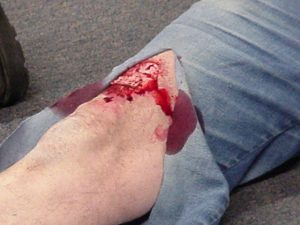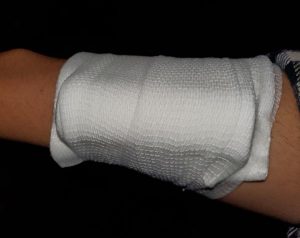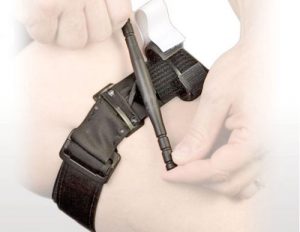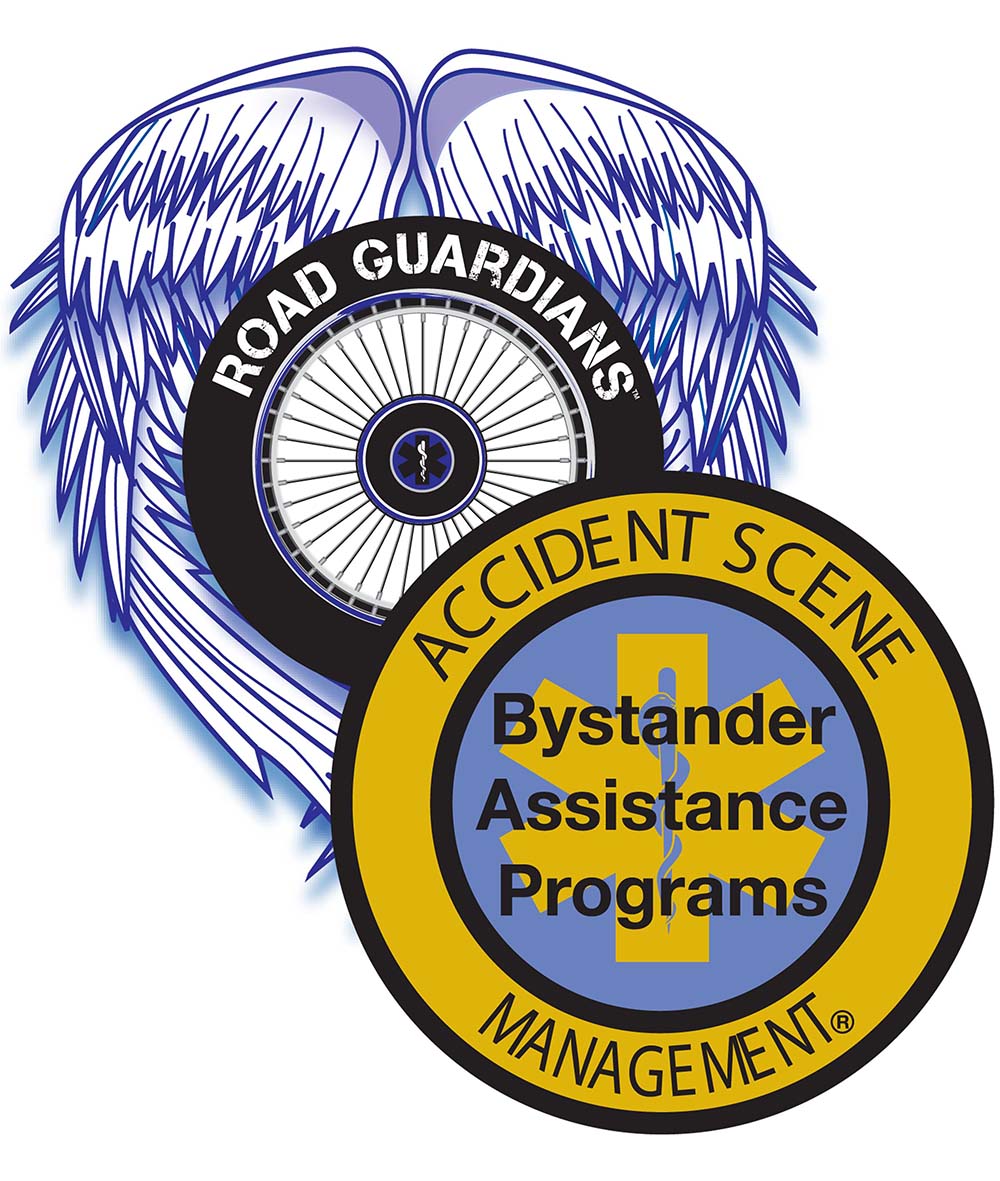 There’s so much to learn about trauma care that there is no way to address all of the components in one article. If I were to be asked what is the most important treatment to learn, I would have to say, “Stop the bleeding that you can see”! There are a number of programs out there that address “STOP the Bleed” and all of them are good and worthwhile. Most of them take about one hour. As a bystander, regardless of the training that you already have, I would recommend that you take that class. Continuing to look for additional tips and tricks and giving consideration to some of the things that you may encounter will help you be more effective if you were called upon to help someone. Now consider that education, is just that, education. While having an education is extremely important, education without tools is like a mechanic without a screwdriver! There are tools that you will need to help you be effective if you need to stop bleeding. I will talk about both education and tools in the tips provided in this article.
There’s so much to learn about trauma care that there is no way to address all of the components in one article. If I were to be asked what is the most important treatment to learn, I would have to say, “Stop the bleeding that you can see”! There are a number of programs out there that address “STOP the Bleed” and all of them are good and worthwhile. Most of them take about one hour. As a bystander, regardless of the training that you already have, I would recommend that you take that class. Continuing to look for additional tips and tricks and giving consideration to some of the things that you may encounter will help you be more effective if you were called upon to help someone. Now consider that education, is just that, education. While having an education is extremely important, education without tools is like a mechanic without a screwdriver! There are tools that you will need to help you be effective if you need to stop bleeding. I will talk about both education and tools in the tips provided in this article.
The first things you will need to do before providing care are, assure that you have a safe scene and call 911. You also need to make sure that you don’t become exposed to another person’s germs so taking the time to put some gloves on and protect your face from potential splashes is always worth the time.
The next thing that you will do is determine where the bleeding is coming from so that you can decide what to do about it. If a person is bleeding from their arms or legs, there is more you can do for them than if they are bleeding from their head, chest, or abdomen.
Let’s start by talking about ARMS and LEGS. If there is severe bleeding, you will want to apply direct pressure to the area that is bleeding. The first piece of gauze you place on that open wound should be sterile. If needed, you can add more gauze or any absorbent material. When you feel you are gaining control over the bleeding you can apply a pressure dressing.
- Do not remove the sterile gauze that you first applied to the wound. Doing so may disrupt clotting.
- Unroll a 3- or 4-inch roll gauze only enough that you can go around the limb twice. Place the remaining roll on top of the sterile gauze and wrap the unrolled portion of the gauze around the limb. Keep the gauze wide as you stretch it over the roll gauze so that it creates uniform pressure. The resulting bandage should be firm but not cut off circulation. See picture.
- Apply manual pressure to the gauze as needed for additional bleeding control.
 A 2nd means of bleeding control is a hemostatic dressing. If you have a dressing with a hemostatic agent such as Quick Clot or Celox, you can use that dressing applied DIRECTLY to the wound. Cover and wrap the wound with a roll gauze if on a limb. Remove your gloves inside out in case there is hemostatic powder on them. The hemostatic agent should not be allowed to touch other surfaces, especially the eyes, nose, or mouth.
A 2nd means of bleeding control is a hemostatic dressing. If you have a dressing with a hemostatic agent such as Quick Clot or Celox, you can use that dressing applied DIRECTLY to the wound. Cover and wrap the wound with a roll gauze if on a limb. Remove your gloves inside out in case there is hemostatic powder on them. The hemostatic agent should not be allowed to touch other surfaces, especially the eyes, nose, or mouth.
The 3rd bleeding control measure to consider is a tourniquet. In a case of severe bleeding from arms or legs, a tourniquet should be considered. If the bleeding is massive and you have attempted direct pressure, or you have no time to apply a dressing due to the seriousness of the injuries then apply a tourniquet. There is very little evidence to suggest that a tourniquet, when applied properly, would cause a person to lose a limb. As a matter of fact, most limb loss would have occurred with our without the tourniquet.
 When a tourniquet is applied it is done with the intention to stop blood flow to that limb. The tourniquet should be made of a material that is wide and soft but not stretchy. Professional tourniquets work best ( CAT or SOF-T) but a tourniquet can be made with items you have on-hand such as a bandana or two that are tied together or a triangular bandage. You will want the material to be around 40 inches long.
When a tourniquet is applied it is done with the intention to stop blood flow to that limb. The tourniquet should be made of a material that is wide and soft but not stretchy. Professional tourniquets work best ( CAT or SOF-T) but a tourniquet can be made with items you have on-hand such as a bandana or two that are tied together or a triangular bandage. You will want the material to be around 40 inches long.
Once applied, do not loosen the tourniquet. If done properly it will be uncomfortable. Be sure to write the time the tourniquet was applied on the tourniquet or on the person’s skin right next to the tourniquet. I recommend that a sharpie be carried along with the tourniquet. Keep the limb uncovered by placing a blanket over the person so that all rescuers can see that there is a tourniquet on the person.
Bleeding from places other than arms or legs & special circumstances.
- If a person is bleeding from an area with a broken bone, do not place pressure over the broken bone. Use a hemostatic agent if it is available or go directly to a tourniquet.
- If a person is bleeding from their head you can place a light dressing on them to absorb the blood and protect the wound but do not place pressure on the wound. You could push a bone shard into brain tissue! We do not know if there is a fractured skull underneath the bleed.
- If a person is bleeding from their neck you can use a hemostatic agent or apply gentle pressure to one side or the other of the neck. be careful that you are not applying pressure to both sides of the neck at the same time!
- If a person is bleeding from their chest you will want to cover their chest wound with a sterile dressing. They may prefer to sit and that is okay as long as there is nothing that they would hit their head on if they were to lose consciousness. It might be best for you to sit behind the person and let them rest against you. You can begin to prepare yourself for what would happen if they became unconscious.
- If a person is bleeding from their belly or pelvis, cover the open wound with a sterile dressing or a hemostatic dressing. Keep the heat and the moisture in by covering the person to keep them warm. Allow them to find a position of comfort, generally with their knees bent.
In all cases where there is severe bleeding, you should have called 911 immediately to get help on its way. If you have followed these simple steps and are willing to help you will make a difference! While you may find these tips useful they do not take the place of training and certification. To learn more about classes or to find a class, CLICK HERE
Article by Vicki Sanfelipo, RN – Author of “A Crash Course for the Motorcyclist”

